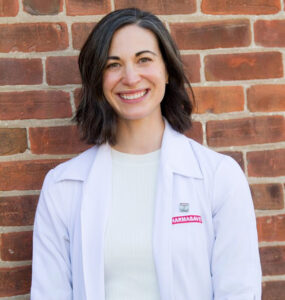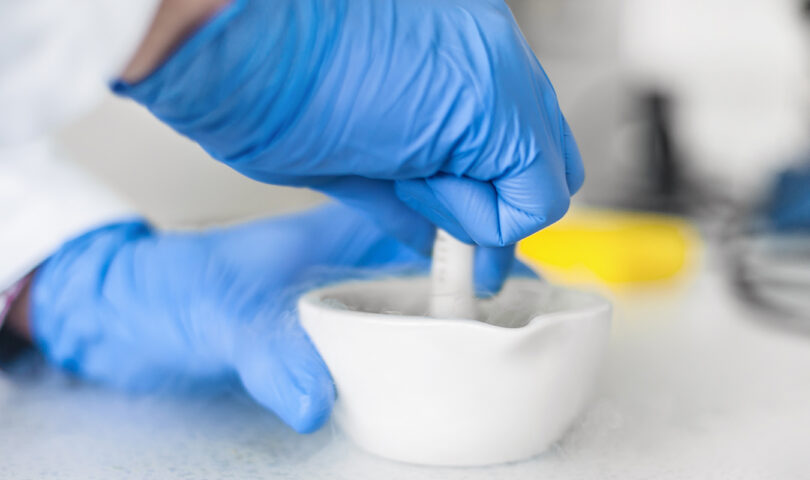Bronwyn Tolmie is the owner of Trailside Pharmacy in Fergus and Elora Apothecary in Elora and has played a key role in implementing the non-sterile compounding standards in her pharmacies. Taking on the role of Compounding Supervisor, Tolmie worked alongside her pharmacy team to successfully implement all phases of the non-sterile compounding standards to keep staff and patients safe.

All pharmacies engaging in non-sterile compounding activities are required to comply with NAPRA’s non-sterile compounding standards. With support from resources available on the College’s website and ongoing training, pharmacies and pharmacy professionals are to continue to work towards full implementation. There are a variety of courses/training available to support pharmacies in non-sterile compounding and it is the responsibility of the Compounding Supervisor to access the appropriateness and applicability of each course compared to the compounding services offered at their pharmacy.
Pharmacy Connection chatted with Tolmie to share her experience implementing the final two phases of the non-sterile compounding standards—personnel training and quality assurance, and facilities and equipment.
At the end of 2019, you spoke to the steps you took to assess risks and gaps in order to meet the phase 1 deadline. Can you describe your approach and process while implementing the final two phases of the non-sterile compounding standards?
Phase 2—personnel training and quality assurance
There were some challenges with this phase as training programs had been temporarily suspended for COVID-related reasons. We opened our second pharmacy in January 2021, at the peak of another COVID-19 wave. However, I was able to identify quality compounding training programs delivered in a virtual format which I, along with a key member of our team, participated in.
Completing formal training with MEDISCA helped solidify my knowledge. The non-sterile compounding course ensured I understood what the proper processes were for preparing non-sterile compounds and reinforced that the knowledge base I had was appropriate to undertake the compounds we were doing.
Earlier this year, a pharmacy technician joined our team with prior experience and training in compounding. The pharmacy technician had completed the PCCA non-sterile compounding course and had sterile compounding training in a hospital setting. Onboarding a highly skilled pharmacy technician and providing in-house training on our policies and procedures has allowed our pharmacy to expand our compounding services.
Ongoing training of current staff involved in compounding, as well as identifying opportunities to train new staff, is part of our quality assurance strategy that is reviewed annually. This includes re-evaluating our mixture files (master formulations), re-assessing whether the compounds we are making are still appropriate for our equipment, training of our staff and pharmacy space, and determining if there are now commercially available products that could be dispensed instead.
As the non-sterile compounding supervisor, I am the first point of contact if compounds come to our pharmacy that we have never made before. I evaluate and discuss with the team if we have the equipment, knowledge and skills to safely make the compound. If not, I help refer the patient to a pharmacy that can prepare that compound.
Leaning on my own compounding experience (both at the hospital and community level), combined with formal online programming, allowed me to ensure my team was sufficiently competent to support our initial compounding practices.
Phase 3—facilities and equipment
As a new pharmacy opening, we were fortunate that we had an awareness of the non-sterile compounding standards and were able to proactively design our pharmacy and dedicated compounding space to meet the standards.
Although the equipment vendors are often quite helpful in understanding the guidelines, they are not perfect in their understanding so pharmacy professionals really have to know the NAPRA standards and guidance document very well.
The MEDISCA non-sterile compounding course I completed was helpful as it gave me access to a pharmacist who had years of compounding experience. I was able to ask some really detailed questions around space and equipment considerations that helped inform my approach.
Finally, reaching out to pharmacy peers who I knew had completed training and had years of experience using equipment on site was valuable. I identified key pharmacy colleagues who I trusted and sought their feedback on how to procure equipment from reputable sources.
Describe the impact the standards have had on your pharmacy practice and on safe, quality patient care.
While the non-sterile compounding standards still require pharmacy professionals to assess their practice and apply interpretation as needed, our team has found it helpful to have clear standards and more detailed guidance for our compounding practices. These high but achievable standards have enhanced the patient care we deliver while also offering a consistent patient experience across compounding pharmacies.
The non-sterile compounding standards have provided enhanced confidence that the patient will receive the same preparation every time, at any pharmacy.
What is some key advice you’d share with other Designated Managers/pharmacy professionals as they continue to meet the non-sterile compounding standards?
The proper prework, including the risk assessment and determining what can be prepared in a regular pharmacy space, really sets pharmacies up for success to safely prepare compounds. The physical act of compounding preparations and training staff within one’s space is important, but in my experience, not the most challenging step.
The prework and ensuring you have the proper space, understand the guidance document, how to interpret it and apply those standards to your practice site was the most challenging aspect. Creating the mixture files involves a lot of research and understanding of the appropriate evidence-based resources to find valid formulations. Once you have your mixture file and master formulation developed, the remainder of the implementation is relatively easy.
Creating high quality drug mixture files and master formulations is vital and where I spent the balance of my time navigating through the non-sterile compounding standard implementation phases. Once these files and formulations are established, they do need to be reviewed as part of our quality assurance process, but the actual execution of non-sterile compounding is a relatively basic technical act.
Once you have the master formulations created, you feel so confident in what you are preparing and dispensing from your pharmacy because you have created the compound in such a safe manner. You know that at the end of the day the product being made and the processes you have in place supports the delivery of safe, quality care.













